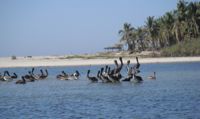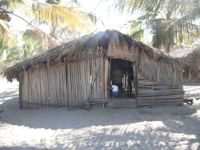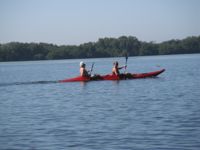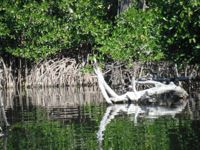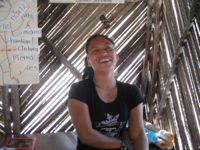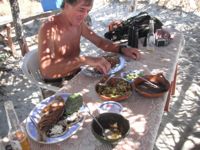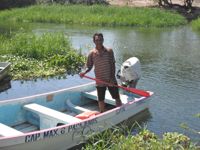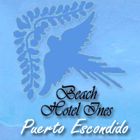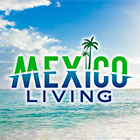Life On The Manialtepec Lagoon
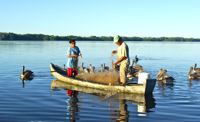
Photo: Michael Malone
The break of day. Dawn fairly floats over the still water of the lagoon and the fishermen in their canoes bring in their nets. There is a myth of an ancient village buried below - a myth that adheres to many lakes. According to an 1883 Oaxaca state survey, San José Manialtepec, then just a hamlet, had 1,300 years earlier been a large community which had "ruled over its neighboring lands."
Today Las Negras is the largest community on the lagoon, with a population of around 200 according to the census, but probably somewhat more, large enough to support a church and a city hall, a school and many civic activities.
The smallest community is Puerto Suelo with only five families, but still large enough for a one-room school house for its 6 children. Going from Las Negras to Puerto Suelo is like going from Puerto to Las Negras or from Oaxaca to Puerto. But before we get to Puerto Suelo, we must cross the lagoon.
The Manialtepec Lagoon is a lake fed by the Manialtepec River for most of the year. In the rainy season, however, it becomes a tidal estuary of the Pacific Ocean. There are two barrier beaches that separate the lagoon from the sea: one, called the Barra, is at the south-west corner at the tip of El Palmarito beach; the other, Barrita, is where the Manialtepec River delta begins, a few hundred meters west of Puerto Suelo.
The river swells in the rainy season and the lagoon rises vertically up to 1.5 meters and floods out of the mangrove forests into the surrounding fields. The restaurants on the north shore start filling their sandbags and the ranchers move their cattle. Then the river leaps the barrier beach at the Barrita. Except usually it doesn’t, because before the water rises to that point, a breach is made in the Barra so that the delta water can enter the sea and the sea can enter the lagoon. An assembly is called of fishermen, farmers, ranchers, and eco-tourism and restaurant operators, and arrangements are made to bring in a backhoe. The breach is opened from the ocean side of the barrier.
When the barrier beach falls the level of the lagoon falls with it, even though the fresh water is partially replenished by the salt water of the sea. This is when the fishermen get their biggest hauls, trapping ocean fish in La Barra their nets. It is also when the lagoon’s giant shrimp go out to sea to spawn. Snook (robalo), mojarra, and red snapper (pargo) are coastal fish that also live in the lagoon.
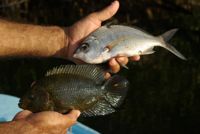
Photo: Michael Malone
After the rainy season ends in November, the river delta recedes, and the barrier beach closes the lagoon again. Now the catch is mostly small fish like mullet (lisa), white mojarra, black axillary mojarra (malacapa) and cat fish (cuatete) as well as shrimp and crabs (jaiva). You will not find malacapa in the market in Puerto, but it is much favored in Pintotepa Nacional where it is used in fish soup.
The fish are caught in gillnets measuring 600 meters by six meters. A gillnet is a nylon mesh curtain, invisible to fish, which is suspended by a system of floats and weights. Each fisherman typically puts out his gillnet at night and retrieves it early in the morning. To prevent overfishing the number of licensed fishermen is regulated by the National Commission of Aquaculture and Fishing (Conapesca). There are now around 120 commercial fishermen in the lagoon.
Birdwatching
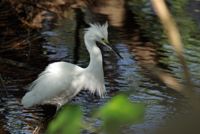
Photo: Michael Malone
The lagoon is very popular with birds, including migratory birds from North America, and with North American birdwatchers, many of whom go out on boat trips with Canadian ornithologist Michael Malone (Hidden Voyages Ecotours www.peleewings.ca). A recent excursion included sightings of vultures, parrots, parakeets, many species of herons and the frigate bird - which attacks other birds mid-air to steal the fish from their beaks.
Puerto Suelo
Puerto Suelo, once a hideout for wanted men seeking to evade the long-arm of the law, is now a peaceful fishing village of a few palapas, plus a one-room schoolhouse. Located on a strip of land between two barrier beaches, it has neither electricity nor running water, but there are groves of coconut palms and other trees, chickens run free, and there’s the delta to bathe in.
There is also a restaurant run by retired fisherman Julio (El Negro) Santos Aragón, his wife Juana (Juanita la Güera) Ríos and their son Javier Santos Ríos. The family is very friendly and will do what they can to make your visit pleasurable. Lunch is the catch of the day served with sopes (a small, thick tortilla with pinched sides that looks like a miniature pizza that is filled with refried beans and crumpled cheese) and a nopal cactus salad. The food is simply fabulous, especially with a cold beer. (The ice for the cooler is brought in from San José Manialtepec, a town on the other side of the highway.) Breakfast or lunch at the restaurant, which has tables on both the ocean and the river sides, is part of many of the lagoon excursions. Another attraction is its clean bathrooms.
Puerto Suelo is also a great getaway destination, both for a day-trip and for a few days. There is a guest palapa with two large beds and mosquito netting, plus hammocks. You can get there by car – the turn-off from the Coast highway is 6 km west of Las Negras; there are signs on both sides of the highway. Then it’s another 2.5 km on a dirt road taking you through farmland and cattle ranches, making the trip about 45 minutes from Puerto Escondido. The road ends at the river. The family will hear your car coming (if not, honk your horn) and Julio or Javier will ferry you across in the launch. (In the dry season you could probably just wade across.) Alternatively, you can hire a launch in Las Negras or you can rent a kayak, but the paddle is 90 minutes each way.
Michael Malone, Hidden Voyages Ecotours
(954) 582 29 62 — December to March
www.peleewings.ca
peleewings@hotmail.com
Lalo Ecotours (954) 588 91 64 laloecotours@hotmail.com
Restaurant / camping "Ribera del Río", Puerto Suelo (954) 107 09 00

